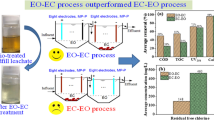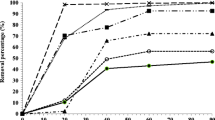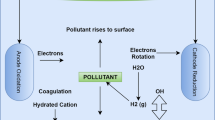Abstract
In this study, electrocoagulation (EC) followed by enhanced electrooxidation (EO) was harnessed to treat a real petrochemical wastewater (PWW). In EC process, two kinds of aluminum and iron electrodes were used and under optimal condition (200 mA applied current) COD removal was achieved 42% and 38% for Al and Fe electrodes, respectively. Combined treatment methods of EO/UV, EO/US, and EO/Fe(II) were assessed in comparison with single EO and COD removal efficiencies of 68, 65, and 60% were obtained for EO/UV, EO/Fe(II), and EO/US processes, respectively. The best COD, TOC, and color removal efficiencies were attained for EO/UV/Fe(II) process being 80, 69, and 91%, respectively. The average oxidation state (AOS) and biodegradability index (BI) of the raw and treated samples by various methods were evaluated and the best promising results were obtained for EO/UV/Fe(II) process which were 1.1 and 0.52 for AOS and BI respectively. Additionally, Zahn-Wellens test was conducted and sample treated by EO/UV/Fe(II) was superior to samples treated by other methods, and in just 5 days, minimum biodegradability extent of 70% was met and finally reached over 95% which is an extraordinary result. Finally, the toxicity of the effluent was markedly reduced after sequential processes.








Similar content being viewed by others
Data Availability
The datasets generated during the current study are available from the corresponding author on reasonable request.
References
Ammar, S. H., Ismail, N. N., Ali, A. D., & Abbas, W. M. (2019). Electrocoagulation technique for refinery wastewater treatment in an internal loop split-plate airlift reactor. Journal of Environmental Chemical Engineering, 7, 103489.
Baird, R. B. (2017). Standard methods for the examination of water and wastewater, 23rd, Water Environment Federation. American Public Health Association, American.
Can, O., Kobya, M., Demirbas, E., & Bayramoglu, M. (2006). Treatment of the textile wastewater by combined electrocoagulation. Chemosphere, 62, 181–187.
Chaturvedi, A., Rai, B. N., Singh, R. S., & Jaiswal, R. P. (2022). A comprehensive review on the integration of advanced oxidation processes with biodegradation for the treatment of textile wastewater containing azo dyes, Reviews in Chemical Engineering, 38, 617–639.
Dong, H., Qiang, Z., Hu, J., & Qu, J. (2017). Degradation of chloramphenicol by UV/chlorine treatment: Kinetics, mechanism and enhanced formation of halonitromethanes. Water research, 121, 178–185.
Eslami, A., Kashani, M. R. K., Khodadadi, A., Varank, G., Kadier, A., Ma, P.-C., Madihi-Bidgoli, S., & Ghanbari, F. (2021). Sono-peroxi-coagulation (SPC) as an effective treatment for pulp and paper wastewater: Focus on pH effect, biodegradability, and toxicity. Journal of Water Process Engineering, 44, 102330.
Eslami, A., Mahdipour, F., Maleksari, H. S., Varank, G., Ghasemi, S. M., Nejatian, P., Bagheri, A., & Madihi-Bidgoli, S. (2023). Enhanced degradation of 2,4-dichlorphenoxyacetic acid herbicide by CaO2 activated by Fe(II) and ultrasound irradiation: Practical insight and mineralization. Korean Journal of Chemical Engineering, 40, 2866–2875.
Eslami, A., Moradi, M., Ghanbari, F., & Mehdipour, F. (2013). Decolorization and COD removal from real textile wastewater by chemical and electrochemical Fenton processes: A comparative study. Journal of Environmental Health Science and Engineering, 11, 31.
Ganzenko, O., Trellu, C., Oturan, N., Huguenot, D., Péchaud, Y., van Hullebusch, E. D., & Oturan, M. A. (2020). Electro-Fenton treatment of a complex pharmaceutical mixture: Mineralization efficiency and biodegradability enhancement. Chemosphere, 253, 126659.
Gao, Y.-Q., Zhang, J., Li, C., Tian, F.-X., & Gao, N.-Y. (2020). Comparative evaluation of metoprolol degradation by UV/chlorine and UV/H2O2 processes. Chemosphere, 243, 125325.
Gao, Z.-C., Lin, Y.-L., Xu, B., Xia, Y., Hu, C.-Y., Zhang, T.-Y., Cao, T.-C., Chu, W.-H., & Gao, N.-Y. (2019). Effect of UV wavelength on humic acid degradation and disinfection by-product formation during the UV/chlorine process. Water research, 154, 199–209.
Ghanbari, F., Moradi, M., Mohseni-Bandpei, A., Gohari, F., Mirtaleb Abkenar, T., & Aghayani, E. (2014). Simultaneous application of iron and aluminum anodes for nitrate removal: A comprehensive parametric study. International Journal of Environmental Science and Technology, 11, 1653–1660.
Ghanbari, F., Riahi, M., Kakavandi, B., Hong, X., & Lin, K.-Y. A. (2020). Intensified peroxydisulfate/microparticles-zero valent iron process through aeration for degradation of organic pollutants: Kinetic studies, mechanism and effect of anions. Journal of Water Process Engineering, 36, 101321.
Ghanbari, F., Yaghoot-Nezhad, A., Wacławek, S., Lin, K.-Y. A., Rodríguez-Chueca, J., & Mehdipour, F. (2021). Comparative investigation of acetaminophen degradation in aqueous solution by UV/Chlorine and UV/H2O2 processes: Kinetics and toxicity assessment, process feasibility and products identification. Chemosphere, 285, 131455.
Gong, C., Ren, X., Han, J., Wu, Y., Gou, Y., Zhang, Z., & He, P. (2022). Toxicity reduction of reverse osmosis concentrates from petrochemical wastewater by electrocoagulation and Fered-Fenton treatments. Chemosphere, 286, 131582.
Guzmán-Duque, F. L., Palma-Goyes, R. E., González, I., Peñuela, G., & Torres-Palma, R. A. (2014). Relationship between anode material, supporting electrolyte and current density during electrochemical degradation of organic compounds in water. Journal of hazardous materials, 278, 221–226.
Hamdaoui, O., Merouani, S., Idir, M. A., Benmahmoud, H. C., Dehane, A., & Alghyamah, A. (2022). Ultrasound/chlorine sono-hybrid-advanced oxidation process: Impact of dissolved organic matter and mineral constituents. Ultrasonics Sonochemistry, 83, 105918.
Hua, Z., Li, D., Wu, Z., Wang, D., Cui, Y., Huang, X., Fang, J., & An, T. (2021). DBP formation and toxicity alteration during UV/chlorine treatment of wastewater and the effects of ammonia and bromide. Water Research, 188, 116549.
Khavari Kashani, M. R., Wang, Q., Khatebasreh, M., Li, X., Sheikh Asadi, A. M., Boczkaj, G., & Ghanbari, F. (2023). Sequential treatment of landfill leachate by electrocoagulation/aeration, PMS/ZVI/UV and electro-Fenton: Performance, biodegradability and toxicity studies. Journal of Environmental Management, 338, 117781.
Liu, F., Zhang, Z., Wang, Z., Li, X., Dai, X., Wang, L., Wang, X., Yuan, Z., Zhang, J., & Chen, M. (2019). Experimental study on treatment of tertiary oil recovery wastewater by electrocoagulation. Chemical Engineering and Processing-Process Intensification, 144, 107640.
Liu, Y., Liu, Z., Zhao, L., Wang, Y., Pan, J., Wang, Q., & Zhang, J. (2018). Removal of NO in flue gas using vacuum ultraviolet light/ultrasound/chlorine in a VUV-US coupled reactor. Fuel Processing Technology, 169, 226–235.
Madihi-Bidgoli, S., Asghari, F., Cheraghi, S., Hamidinia, H., Shagerdi, E., & Asadnezhad, S. (2023). UV/periodate and UV/chlorine for dye degradation and real wastewater treatment: A comparative study. Water Practice and Technology, 18, 2453–2468.
Malik, S. N., Ghosh, P. C., Vaidya, A. N., & Mudliar, S. N. (2020). Hybrid ozonation process for industrial wastewater treatment: Principles and applications: A review. Journal of Water Process Engineering, 35, 101193.
Martínez-Huitle, C. A., & Panizza, M. (2018). Electrochemical oxidation of organic pollutants for wastewater treatment. Current Opinion in Electrochemistry, 11, 62–71.
Meghlaoui, F. Z., Merouani, S., Hamdaoui, O., Bouhelassa, M., & Ashokkumar, M. (2019). Rapid catalytic degradation of refractory textile dyes in Fe (II)/chlorine system at near neutral pH: radical mechanism involving chlorine radical anion (Cl2−)-mediated transformation pathways and impact of environmental matrices. Separation and Purification Technology, 227, 115685.
Phattarapattamawong, S., Chareewan, N., & Polprasert, C. (2021). Comparative removal of two antibiotic resistant bacteria and genes by the simultaneous use of chlorine and UV irradiation (UV/chlorine): Influence of free radicals on gene degradation. Science of the Total Environment, 755, 142696.
Khavari Kashani, M. R., Kiani, R., Hassani, A., Kadier, A., Madihi-Bidgoli, S., Andrew Lin, K.-Y., & Ghanbari, F. (2022). Electro-peroxone application for ciprofloxacin degradation in aqueous solution using sacrificial iron anode: A new hybrid process. Separation and Purification Technology, 292, 121026.
Syam Babu, D., Anantha Singh, T., Nidheesh, P., & Suresh Kumar, M. (2020). Industrial wastewater treatment by electrocoagulation process. Separation Science and Technology, 55, 3195–3227.
Torres, R. A., Sarria, V., Torres, W., Peringer, P., & Pulgarin, C. (2003). Electrochemical treatment of industrial wastewater containing 5-amino-6-methyl-2-benzimidazolone: Toward an electrochemical–biological coupling. Water Research, 37, 3118–3124.
Un, U. T., Altay, U., Koparal, A. S., & Ogutveren, U. B. (2008). Complete treatment of olive mill wastewaters by electrooxidation. Chemical Engineering Journal, 139, 445–452.
Wang, L., Ye, C., Guo, L., Chen, C., Kong, X., Chen, Y., Shu, L., Wang, P., Yu, X., & Fang, J. (2021). Assessment of the UV/chlorine process in the disinfection of Pseudomonas aeruginosa: Efficiency and mechanism. Environmental Science & Technology, 55, 9221–9230.
Welter, J. B., Soares, E. V., Rotta, E. H., & Seibert, D. (2018). Bioassays and Zahn-Wellens test assessment on landfill leachate treated by photo-Fenton process. Journal of environmental chemical engineering, 6, 1390–1395.
White, G. C. (2010). White’s handbook of chlorination and alternative disinfectants. Wiley.
Yaghoot-Nezhad, A., Wacławek, S., Madihi-Bidgoli, S., Hassani, A., Lin, K.-Y. A., & Ghanbari, F. (2022). Heterogeneous photocatalytic activation of electrogenerated chlorine for the production of reactive oxygen and chlorine species: A new approach for Bisphenol A degradation in saline wastewater. Journal of Hazardous Materials, 445, 130626.
Funding
This research project has been financially supported by Behbahan Faculty of Medical Sciences (Iran) under contract number of IR.BHN.REC.1399.040.
Author information
Authors and Affiliations
Corresponding authors
Ethics declarations
Conflict of Interest
The authors declare no competing interests.
Additional information
Publisher’s Note
Springer Nature remains neutral with regard to jurisdictional claims in published maps and institutional affiliations.
Rights and permissions
Springer Nature or its licensor (e.g. a society or other partner) holds exclusive rights to this article under a publishing agreement with the author(s) or other rightsholder(s); author self-archiving of the accepted manuscript version of this article is solely governed by the terms of such publishing agreement and applicable law.
About this article
Cite this article
Feizi, R., Khavari Kashani, M.R., Jaafarzadeh, N. et al. The Combination of Electrocoagulation and Enhanced Electrooxidation for the Treatment of Petrochemical Wastewater: Biodegradability Studies. Water Air Soil Pollut 234, 777 (2023). https://doi.org/10.1007/s11270-023-06789-5
Received:
Accepted:
Published:
DOI: https://doi.org/10.1007/s11270-023-06789-5




